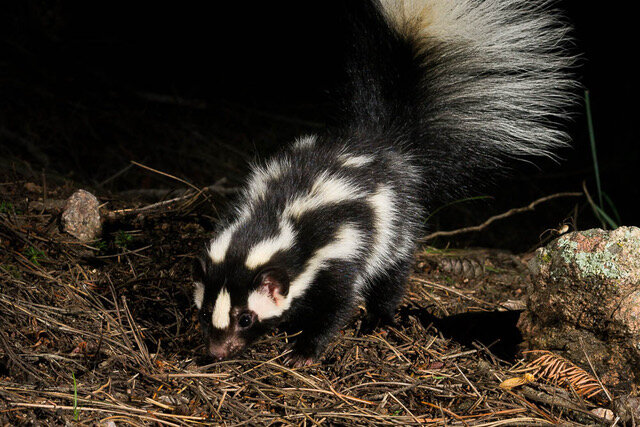Encounters with Nature: The Western Spotted Skunk
By Carron Meaney , Ph.D., co-author of The Mammals of Colorado .
The uncommon, diminutive, and spotted skunk inhabits rocky canyons, foothills, and montane riparian habitats below 8,000 feet in elevation. It uses rocky outcrops and logs for dens and can be found near where people live. Western spotted skunks occur through much of Mexico and the western United States. They are never common and therefore are not often seen, although Boulder County provides suitable habitat.
We have four species of skunks in Colorado: The striped skunk (the common one); the white-backed hog-nosed skunk, which is rare and occurs in southeastern Colorado; the eastern spotted skunk, which occurs along the South Platte and Arkansas rivers in far eastern Colorado; and the western spotted skunk, scientific name Spilogale gracilis .
Western spotted skunk. Photo by James Beissel
Western spotted skunks are black and white, with broad white stripes broken up into spots, and they sport a white-tipped tail. The tail is conspicuously large and long-haired. They have white spots below their ears and in the middle of their forehead. This species weighs about a pound, with males weighing slightly more and females weighing slightly less.
They are omnivorous and eat arthropods, including grasshoppers and caterpillars; small mammals such as mice and voles; birds and their eggs; lizards; and roots, fruits, and berries. As with other skunks, spotted skunks are nocturnal. They stay within a half mile of their den. They can climb and are excellent diggers, with relatively long claws on their front feet.
When threatened, they will stomp their forefeet and raise their back end into a hand stand posture, which, with their bushy tail, makes them appear larger than they are. I have uploaded a video from Jim Knopf; about halfway through the skunk postures in response to a raccoon not visible off to the side (video link: https://youtu.be/imgQ1EsyUCA ). Spotted skunks have anal glands, and can spray at predators with surprisingly good aim, but need to have their front feet on the ground to do so. One of the anal gland ingredients is mercaptan, which is used in gas lines so that people can quickly detect a leak.
They mate in the fall, when females come into estrus. They have delayed implantation, such that the fertilized egg does not implant in the uterus until April. Four young are born in May or early June, blind and almost hairless. While the young are with their mother, they typically follow her in a single file. They do not hibernate, but may den up in groups during cold periods. They have been known to live for 10 years in captivity. Their predators are humans, dogs, cats, bobcats, foxes, coyotes, owls, and other raptors.
A number of years ago I was living on Sugarloaf and my cousin Andy came to stay. He decided to sleep out for a couple of nights. One morning he woke up with a spotted skunk sleeping on his chest! Although not advised and requiring a permit, spotted skunks can be a fun pet/companion once their anal glands are removed. They are quite friendly and can be litter trained.
Very little is known about this elusive and infrequently-seen species. I am always interested if you see one!

